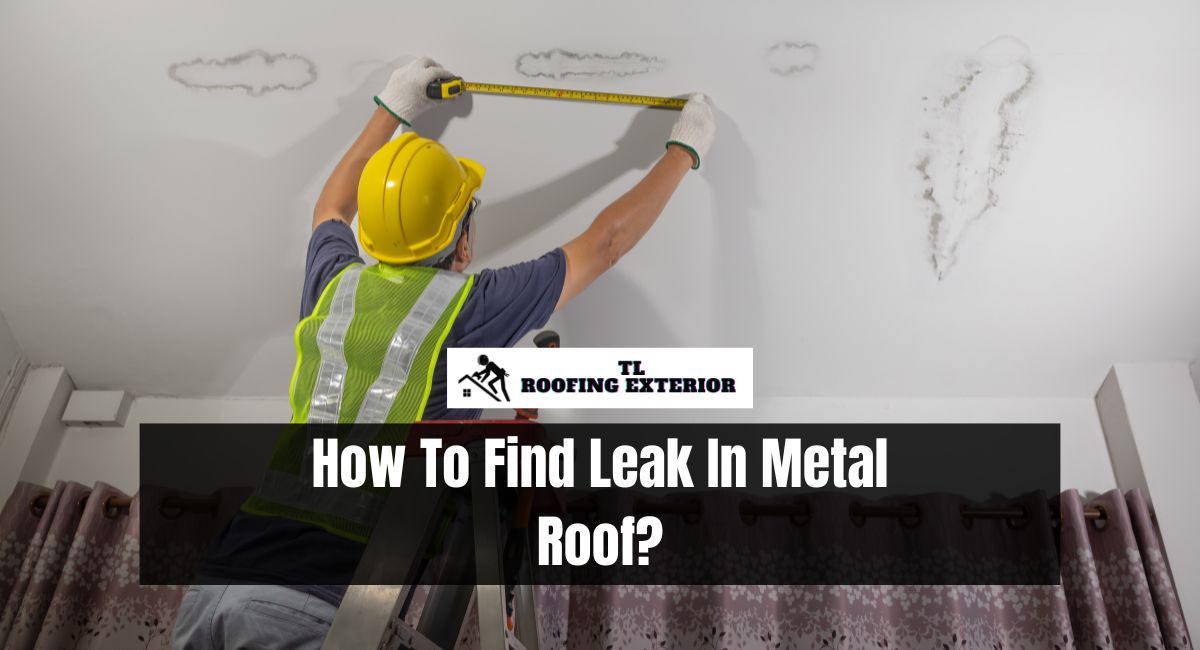A metal roof is frequently praised for its sturdiness and minimal maintenance needs, but like any other roofing material, it is susceptible to leaks. Detecting a leak in a metal roof can be difficult because water can travel along the metal panels, making the source of the leak difficult to pinpoint.
Whether you’re experiencing dripping during a deluge or observing water stains on your ceiling, locating and repairing the source of the leak is essential for preventing further damage.
This article will walk you through the process of accurately locating a leak in a metal roof, along with helpful hints and techniques.
How To Find Leak In Metal Roof?
Finding a leak in a metal roof can be a challenging task, but it’s crucial for preventing further damage to your home. Here’s a step-by-step guide to help you locate the leak:
Preliminary Steps
- Safety First: Before beginning, ensure that you have the appropriate safety equipment, including non-slip shoes, gloves, and eye protection. Never attempt to ascend a roof that is wet or icy.
- Visual Inspection: Use binoculars to visually investigate the roof from the ground using binoculars. Look for damage indicators such as rust, loose fasteners, and missing panels.
- Inside Inspection: Look for signs of water damage, such as dark patches or mold, in the attic or space directly under the roof.
On the Roof
- Climb Safely: Utilize a stable ladder to gain access to the rooftop. Ensure the ladder is securely anchored and that you have a spotter.
- Check the Seams: Frequently, metal roofs consist of panels that interlock. The joints between these panels are common escape points. Look for any separation or damage indicators.
- Inspect Flashings: Flashings are metal pieces used to seal the roof’s edges and corners, particularly around chimneys, vents, and where the roof joins the walls. Check for flashings that are loose, damaged, or corroded.
- Look for Loose Fasteners: Over time, screws and fasteners can become loose, creating water entry points. Replace missing or corroded fasteners and tighten any that are loose.
- Check Roof Penetrations: Vents, skylights, and chimneys are typical locations for roof leakage. Examine the seals and flashings surrounding these elements.
- Water Test: If you are still unable to locate the problem, you can conduct a water test. While you spray water on different sections of the roof with a hose, someone inside the house should be on the lookout for leakage. Commence at the bottom and work your way up.
Additional Tips
- Take Photos: Photograph any indications of damage or prospective problem areas. This can be useful for insurance claims and professional consultations.
- Mark Areas: Use chalk to indicate potential breach locations. This will facilitate the application of repairs.
- Consult a Professional: If you are unable to locate the leak or if the breach is extensive, it may be best to consult a professional for a thorough inspection and repair.
- Weather Conditions: Always check the weather forecast before attempting to locate a leak. This labor is most secure when performed in dry conditions.
- Regular Maintenance: Regular inspections of your roof can help you detect breaches before they become a major problem. Consider scheduling periodic professional examinations.
By following these steps and tips, you can effectively locate a leak in your metal roof and take the necessary steps to repair it, either by yourself or with professional help.
What Is The Most Common Metal Roof Leaks?
Metal roof leaks commonly occur in the following areas:
- Seams and Joints: Over time, the sealant or fasteners can fail, allowing water to seep through.
- Flashing: The metal strips around chimneys, vents, and skylights can corrode or become detached, leading to leaks.
- Screw Holes: Incorrectly installed or loose screws can create entry points for water.
- Ridge Caps: The covering on the peak of the roof can sometimes allow water ingress if not properly sealed.
- Penetrations: Vents, skylights, and other roof features can be weak points if not properly installed or sealed.
Regular maintenance, including checking these common problem areas and reapplying sealants or tightening fasteners, can help prevent leaks.
Where Do Most Roof Leaks Come From?
Most roof leaks commonly originate from:
- Flashing: These metal strips around chimneys, vents, and intersections are prone to corrosion or detachment, leading to leaks.
- Shingles or Tiles: Damaged, missing, or worn-out shingles or tiles can expose the underlayment, making it susceptible to leaks.
- Valleys: The V-shaped areas where two roof slopes meet are high-flow areas for water, making them vulnerable to leaks if not properly sealed.
- Gutters: Clogged or poorly installed gutters can cause water to back up and seep under the roofing material.
- Vent Boots: The rubber or metal casing around roof vents can crack or decay, allowing water in.
Regular inspections and maintenance can help identify and fix these issues before they lead to significant water damage.
Conclusion
Finding a leak in a metal roof requires a systematic approach involving visual inspection, water testing, and sometimes the removal of roof panels for a closer examination. Check the roof’s seams, fasteners, and any roof penetrations, such as vents and skylights.
Some leaks may be readily detected and repaired with sealants or new fasteners, whereas others may require professional evaluation and repair. The sooner you locate and remedy the leak, the less likely you are to experience extensive water damage or expensive repairs.
Read More: What Does A New Roof Consist Of?
